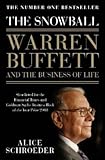The Snowball: Warren Buffett and the Business of Life
- New
- Mint Condition
- Dispatch same day for order received before 12 noon
- Guaranteed packaging
- No quibbles returns
THE NUMBER ONE BESTSELLER Shortlisted for the Financial Times and Goldman Sachs Business Book of the Year Prize 2008Alice Schroeder’s The Snowball: Warren Buffett and the Business of Life might well be one of the most important books you will ever read — particularly in a period when the world’s various economies appear to be entering freefall. This arm-straining (at nearly a thousand pages) but utterly fascinating book has already — against all the odds — achieved an astonishing level
List Price: £12.99
Price: [wpramaprice asin=”0747596492″]
[wpramareviews asin=”0747596492″]
[wprebay kw=”warren+buffett” num=”0″ ebcat=”-1″] [wprebay kw=”warren+buffett” num=”1″ ebcat=”-1″]




Too long winded, can’t see who this book is aimed at, certainly not the coattail investors.,
The bottom line is, at 976 pages, you must really be obsessed with Buffet to put yourself through this.
I’m not saying the book isn’t well researched or written but you have to ask yourself, what is the point of this book and why are you reading it?
Speaking for myself, although I assume many had a similar motivation, you might want to find out more about what goes on in Buffett’s mind. How does he make such good investment decisions, maybe we can learn something from him. If that’s where you are coming from then I recommend Security Analysis by Benjamin Graham with foreword by Buffet. That in conjunction with a book on his most famous quotes for entertainment value.
I’m typically the sort of person that reads a book from start to finish but this one I had to drop before the half-way point. If you’re truly a Buffet fan then you’ll appreciate the concept of opportunity cost. Instead of reading 976 pages of over elaborate descriptions one who met with whom, what they ate, what they drank, how they split the bill your time could be spent on more useful pursuits/books.
Was this review helpful to you?

|To a great extent, his life has been business…and business has been his life,
I recently re-read Roger Lowenstein’s biography, Buffett: The Making of an American Capitalist (first published in 1995 and now re-issued with a new Afterword), and then read this more recent one by Alice Schroeder. Both are first-rate. Which to select if reading only one? That depends on how much you wish to know about Buffett’s personal life, including his relations with various family members, and how curious you are about his personal hang-ups, peculiarities, eccentricities, fetishes, etc. If you can do without any of that, Roger Lowenstein’s biography is the one to read. I also highly recommend the recently published Second Edition of The Essays of Warren Buffet: Lessons for Corporate America, with content selected, arranged, and introduced by Lawrence Cunningham.
The heft of Schroeder’s biography may discourage some people from obtaining a copy. To them I presume to suggest that they not be deterred by that factor. Schroeder has a lively, often entertaining writing style that drives the narrative through just about every period and (yes) interlude of Warren Buffett’s life and career thus far. There is much more information provided than most readers either need or desire. However, she had unprecedented access not only to Buffett but to just about everyone else with whom he is (or once was) associated as well as to previously inaccessible research resources. It is possible but highly unlikely that anyone else will write a more comprehensive biography than Schroeder has, at least for the next several years, if not decades. Also, her opinion of Buffett seems to me to be balanced and circumspect. No doubt he wishes that certain details about his life and career were not included. However, there has been no indication from him or those authorized to represent him that any of the material in this biography (however unflattering) is either inaccurate or unfair. Both halos and warts are included.
Others have shared their reasons for holding this book in high regard. Here are two of mine. First, although I had already read various Buffett’s chairman’s letters that first appeared in a series of Berkshire Hathaway’s annual reports, I did not understand (nor could I have understood) the context for observations he shared, especially his comments about especially important 12-month periods throughout BRK’s history. Schroeder provides the context or frame-of-reference I needed but previously lacked. For example, whereas in previous letters, Buffett merely offered brief updates on how each BRK company was doing, in 1978 he began to share his thoughts about major business topics such as performance measurement for management and why short-term earnings were a poor criterion for investment decisions. With the help of Carol Loomis, especially since 1977, his chairman’s letters “had grown more personal and entertaining by the year; they amounted to crash courses in business, written in clear language that ranged from biblical quotations to references to Alice in Wonderland, and princesses kissing toads.” As Schroeder explains, these gradual but significant changes of subject and tone reflect changes in Buffett’s personal life as he became more reflective about business principles and more appreciative of personal relationships. His children were growing up and departing the “nest” in Omaha. His wife Susie decided to relocate to San Francisco. Meanwhile, his personal net worth continued to increase substantially. His national and then international recognition also increased. The “Oracle of Omaha” had finally become sufficiently confident of himself to reveal to others “a sense of him as a man.”
I also appreciate how carefully Schroeder develops several separate but related themes that help her reader to manage the wealth of information she provides. The biography’s title suggests one of these themes: the “snowball” effect that compounded interest can have. From childhood when he began to sell packs of gum (but not single sticks) and bottles of soda, and a money changer was his favorite toy, Buffett was fascinated by the way that numbers “exploded as they grew at a constant rate over time was how a small sum could be turned into a fortune. He could picture the numbers compounding as vividly as the way a snowball grew when he rolled it across the lawn. Warren began to think about it a different way. Compounding married the present to the future. If a dollar today was going to be worth ten some years from now, then in his mind the two were the same.” Early in life, Buffett avoided making any purchases unless they were almost certain to generate compound interest. This theme is central to understanding Buffett’s investment principles and to his own leadership of BRK. It also helps to explain why he could become physically ill when an investment cost others the funds they had entrusted to his care. Other themes include his determination to simplify his life to the extent he…
Read more
Was this review helpful to you?

|Well worth the money – a good read.,
The book starts well although it reads a bit like a hagiography written by Arthur Hailey. That is ok by me I like Arthur Hailey and have always regarded Buffett as a saint. I laughed out loud several times during the first 50 pages.
After this it gets a bit heavier going. There are many insights and many surprises. I had not realised that Berkshire Hathaway lost money from the start and wound up having the textile mill shut down. I had not reliased that Buffett was first a director of Salomon brothers and then became chairman appointed to clean up the mess which he seems to have done with great honour distinction and dignity. I liked the account of the arbitration with the former director Gutfreund who seems to have had it coming. His views on how derivatives spawn risk rather than remove it are very current today. Also his views on the Efficient Market Hypothesis have always been my own and not current orthodoxy.
A trifle over-written but very moving at the death of this friend Kay Graham and at the death of his wife Susie. Remarkable for the close friendship he enjoys with Bill and Melinda Gates and his partner Charlie Munger.
Was this review helpful to you?

|